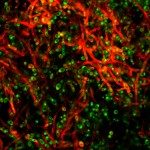Lien vers Pubmed [PMID] – 27150623
Semin. Cell Dev. Biol. 2016 Sep;57:69-75
The ability to grow as filamentous hyphae defines the lifestyle of fungi. Hyphae are exposed to a variety of chemical stimuli such as nutrients or signal molecules from mating partners and host organisms. How fungi sense and process this chemical information to steer hyphal growth is poorly understood. Saccharomyces cerevisiae and Neurospora crassa have served as genetic models for the identification of cellular components functioning in chemotropism. A recent study in the pathogen Fusarium oxysporum revealed distinct MAPK pathways governing hyphal growth towards nutrient sources and sex pheromones or plant signals, suggesting an unanticipated complexity of chemosensing during fungus-host interactions.

